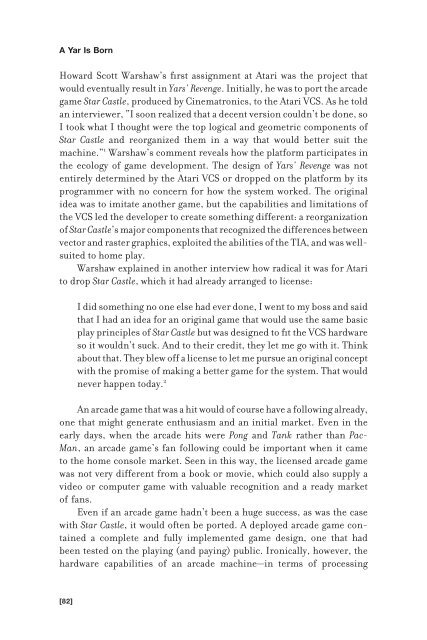Racing the Beam : the Atari Video Computer System - Index of
Racing the Beam : the Atari Video Computer System - Index of
Racing the Beam : the Atari Video Computer System - Index of
Create successful ePaper yourself
Turn your PDF publications into a flip-book with our unique Google optimized e-Paper software.
A Yar Is Born<br />
Howard Scott Warshaw’s fi rst assignment at <strong>Atari</strong> was <strong>the</strong> project that<br />
would eventually result in Yars’ Revenge. Initially, he was to port <strong>the</strong> arcade<br />
game Star Castle, produced by Cinematronics, to <strong>the</strong> <strong>Atari</strong> VCS. As he told<br />
an interviewer, “I soon realized that a decent version couldn’t be done, so<br />
I took what I thought were <strong>the</strong> top logical and geometric components <strong>of</strong><br />
Star Castle and reorganized <strong>the</strong>m in a way that would better suit <strong>the</strong><br />
machine.” 1 Warshaw’s comment reveals how <strong>the</strong> platform participates in<br />
<strong>the</strong> ecology <strong>of</strong> game development. The design <strong>of</strong> Yars’ Revenge was not<br />
entirely determined by <strong>the</strong> <strong>Atari</strong> VCS or dropped on <strong>the</strong> platform by its<br />
programmer with no concern for how <strong>the</strong> system worked. The original<br />
idea was to imitate ano<strong>the</strong>r game, but <strong>the</strong> capabilities and limitations <strong>of</strong><br />
<strong>the</strong> VCS led <strong>the</strong> developer to create something different: a reorganization<br />
<strong>of</strong> Star Castle’s major components that recognized <strong>the</strong> differences between<br />
vector and raster graphics, exploited <strong>the</strong> abilities <strong>of</strong> <strong>the</strong> TIA, and was wellsuited<br />
to home play.<br />
Warshaw explained in ano<strong>the</strong>r interview how radical it was for <strong>Atari</strong><br />
to drop Star Castle, which it had already arranged to license:<br />
[82]<br />
I did something no one else had ever done, I went to my boss and said<br />
that I had an idea for an original game that would use <strong>the</strong> same basic<br />
play principles <strong>of</strong> Star Castle but was designed to fi t <strong>the</strong> VCS hardware<br />
so it wouldn’t suck. And to <strong>the</strong>ir credit, <strong>the</strong>y let me go with it. Think<br />
about that. They blew <strong>of</strong>f a license to let me pursue an original concept<br />
with <strong>the</strong> promise <strong>of</strong> making a better game for <strong>the</strong> system. That would<br />
never happen today. 2<br />
An arcade game that was a hit would <strong>of</strong> course have a following already,<br />
one that might generate enthusiasm and an initial market. Even in <strong>the</strong><br />
early days, when <strong>the</strong> arcade hits were Pong and Tank ra<strong>the</strong>r than Pac-<br />
Man, an arcade game’s fan following could be important when it came<br />
to <strong>the</strong> home console market. Seen in this way, <strong>the</strong> licensed arcade game<br />
was not very different from a book or movie, which could also supply a<br />
video or computer game with valuable recognition and a ready market<br />
<strong>of</strong> fans.<br />
Even if an arcade game hadn’t been a huge success, as was <strong>the</strong> case<br />
with Star Castle, it would <strong>of</strong>ten be ported. A deployed arcade game contained<br />
a complete and fully implemented game design, one that had<br />
been tested on <strong>the</strong> playing (and paying) public. Ironically, however, <strong>the</strong><br />
hardware capabilities <strong>of</strong> an arcade machine—in terms <strong>of</strong> processing


